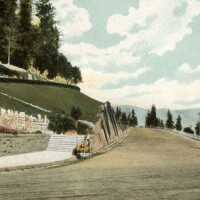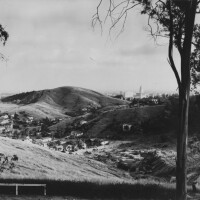They Moved Mountains to Build Dodger Stadium

They literally moved mountains to create Dodger Stadium. Between 1959 and 1962, an army of construction workers shifted eight-million cubic yards of earth and rock in the hills above downtown Los Angeles, refashioning the rugged terrain once known as the Stone Quarry Hills into a modern baseball palace.
Controversy surrounds the stadium's origins. First, a never-realized public housing project erased an entire Mexican American community from Chavez Ravine. Later, the city of Los Angeles enticed Walter O'Malley's Dodgers to the site with what council member Ed Roybal called a "sweetheart deal" -- one that displaced the community's few remaining holdouts. But once ground was broken on September 19, 1959, the construction of Dodger Stadium, a project overseen by O'Malley and architect Emil Praeger and executed by Alhambra-based Vinnell Constructors, was a relatively straightforward project of muscle and machinery.
Workers met their greatest challenge in the site's topography. Steep slopes and deep ravines had long sheltered the Elysian Hills (also called the Stone Quarry or Rock Quarry hills) from intensive development. In 1883, the city set aside the northern half of the land, then considered worthless, as Elysian Park. The other half eventually became home to the bucolic neighborhoods of Bishop, La Loma, and Palo Verde.
But the rough terrain was no match for modern industrial technology. In a little less than 31 months, nineteen giant earthmovers relocated eight million cubic yards of earth, flattening hills and filling in gullies across the 300-acre site. At the highest point, a 726-foot promontory variously called Mount Lookout, Silverwood Hill, and O'Malley Hill, they amputated the peak and carved an amphitheater into the mountainside that would serve as the stadium's foundation. (The landform named Chavez Ravine remained intact. Stadium Way runs through it today.)
Building the 124-foot grandstand was almost as herculean a task as the grading. Some 40,000 cubic yards of concrete, including 78 precast frames, and 13 million pounds of reinforcing steel went into the structure. Because the largest precast pieces were too big to move by truck, Vinnell built a six-acre casting yard on the site. To assemble the pieces, the contractor imported a $150,000 crane from Germany that was then was the largest in North America.
At the project's peak, Vinnell employed 342 workers on the site. Total costs ran close to $23 million, including $4.47 million in city and county subsidies.

Dodger Stadium nearly missed its scheduled opening date after spring storms twice dealt major delays to construction crews. A month before its planned opening, the right field pavilion had yet to rise from the ground. But the workers rallied, and on April 10, 1962, 52,564 fans enjoyed the modern conveniences of O'Malley's new ballpark.
The grandstand's cantilevered design meant that each spectator enjoyed an unobstructed view of the action -- a departure from older stadium designs that placed support structures between fans and the field. And because it was built into the hillside, the grandstand offered easy access from each of its four tiers to the terraced parking lots behind it, minimizing the need for long climbs up stairways.
While the stadium's fresh, modern design might have made a statement on Opening Day 1962, the team didn't. They fell to the Cincinnati Reds, 6 to 3. But the following day, Dodgers ace Sandy Koufax stepped onto the stadium's clay mound and, standing before the bowl-shaped amphitheater that had only recently been carved from a mountainside, hurled a four-hit complete game. The Dodgers won, 6 to 2.





















